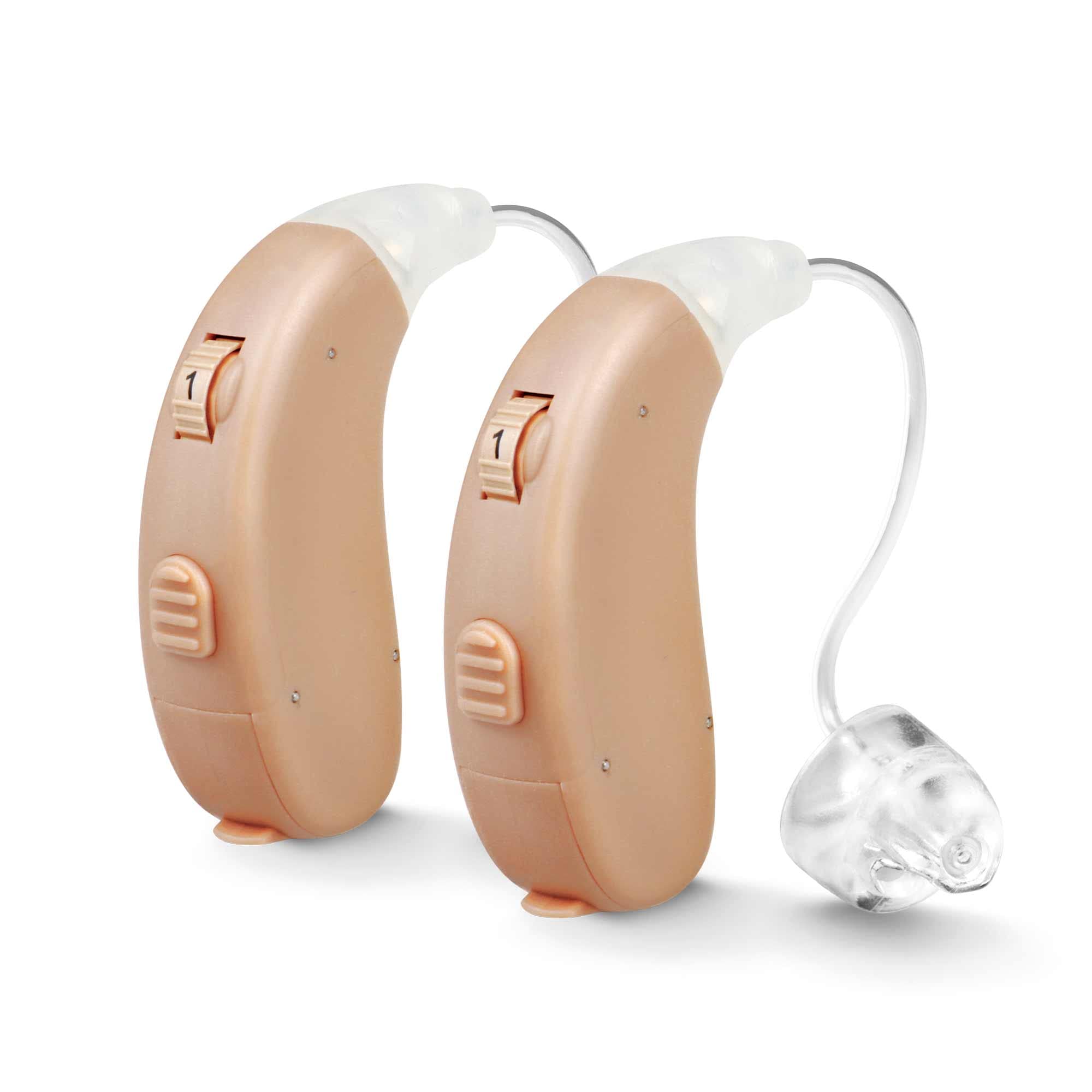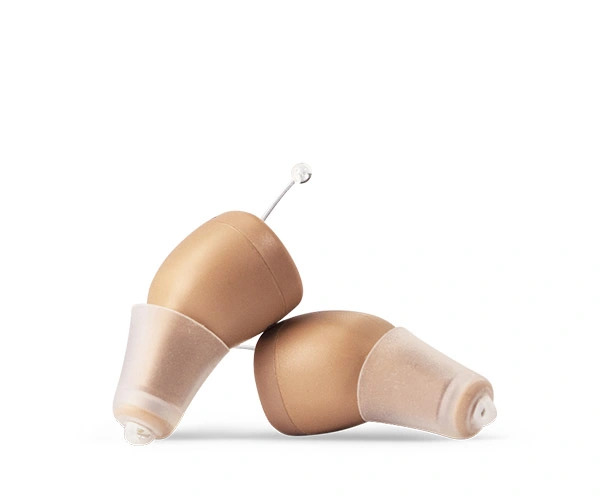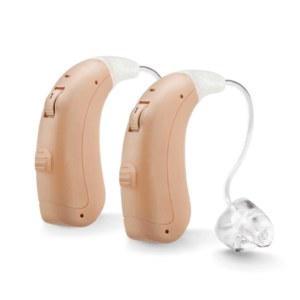MDHearing Review
MDHearing (formerly MDHearingaid) is an FDA-registered online provider of OTC hearing aids. Check out our product breakdown to see if MDHearing hearing aids are right for you.
AgingInPlace.org keeps our resources free by working as an affiliate partner with some companies mentioned on our site. These partnerships or the commission we may earn do not affect our opinions or evaluations of the products we mention. Our reviews are solely based on our research methodology and from input from our AgingInPlace.org Advisory Board. Learn more about our ad policies.
MDHearing Review
Products carousel
Key Takeaways
- MDHearing hearing aids are affordable over-the-counter options for those with mild to moderately severe hearing loss.
- The brand offers two styles: In-the-canal (ITC) and behind-the-ear (BTE).
- The most positively reviewed MDHearing hearing aid is the AIR for its comfort and sound quality. The most negatively reviewed MDHearing hearing aid is the NEO for its uncomfortable ITC fit.
MDHearing is known for its affordable over-the-counter (OTC) hearing aids, outpricing many other OTC hearing brands while still offering quality sound to users. For many, the price of hearing aids is one of the main reasons hearing loss goes unaddressed, so budget-friendly OTC brands like MDHearing can help you hear better without breaking the bank.
The FDA passed a ruling in October 2022 that regulates all OTC hearing aids as of April 2023. The ruling benefits 30 million Americans who need access to affordable hearing aids. Claire Johnson, Au.D., an audiologist and communication consultant at UnitedHealthcare Hearing, recommended getting help as soon as you need it. “If you or a loved one believe you may be experiencing moderate hearing loss, it is important to access care as soon as possible. That’s because starting to wear hearing aids when the condition first arises may help your ears adapt to the reintroduction of lost sounds more effectively,” she said.
If you need immediate and affordable care for mild to moderately severe hearing loss, MDHearing can help. However, if you have hearing loss in the severe to profound range, it’s a good idea to see an audiologist who can recommend the right hearing aid for you.
Why We Reviewed MDHearing
We performed in-house testing on MDHearing and other OTC hearing aid brands to help you make informed decisions about your hearing health. From trying on hearing aids to analyzing customer reviews, we’ve collected all the details you need to understand if you’re buying a product that’s appropriate for your needs and lifestyle.
MDHearing has repeatedly ranked well in our research, taking the spot for “Best Value” in our Best Hearing Aids of 2023 article. Our team has also spotlighted the brand as the best basic device and one of the most affordable on the market. But it doesn’t fit everyone’s needs. Some people need prescription hearing aids that address severe to profound hearing loss, and MDHearing doesn’t provide the technology.
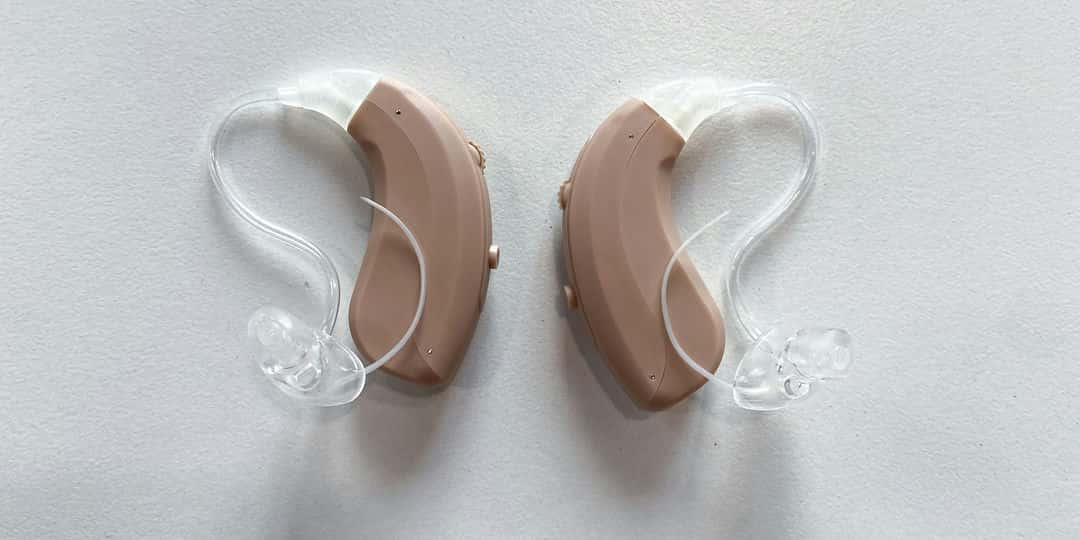
Why Choose MDHearing Hearing Aids
MDHearing hearing aids are attractive to buyers, but they’re not for everyone. Take these pros and cons into account before you purchase.
Pros
-
Over-the-counter availability
-
Budget-friendly price points with available financing options
-
One-year warranty with 45-day trial period and affordable protection plans
-
Online hearing test available with an audiogram
-
User-friendly app available for VOLT MAX model, which offers remote fine-tuning
-
Newest models have rechargeable batteries
-
Lifetime support from audiologists and hearing professionals included
-
Generally positive customer reviews
Cons
-
Doesn’t address severe to profound hearing loss
-
Doesn’t always come with spare care accessories like domes
-
Customer support is difficult to reach
-
Only the VOLT MAX model has Bluetooth capabilities
-
Only available to purchase online
-
Only AIR has telecoil
-
History of poor advertising practices
Why You Can Trust Our Expert Review
Our experts independently research and recommend products we believe provide value in the lives of our readers. We’ve spent collectively more than 5,000 hours conducting in-depth research on hearing aids. Throughout this process, we did the following:
- Engaged in ongoing independent research
- Consulted with independent audiologists
- Consulted with geriatric care experts
- Mystery shopped the brands
- Surveyed hundreds of hearing aid users
- Tested various models of hearing aids
- Interviewed experts in the field
- Read thousands of verified customer reviews from trusted third parties such as Better Business Bureau and Consumer Reports
See our full Hearing Aids Ratings Methodology.
Comparison Table of MDHearing Hearing Aid Models
| Cost | Style | Type of Hearing Loss | Rechargeable | Battery life | Bluetooth | Telecoil | |
|---|---|---|---|---|---|---|---|
| AIR | $399.99 single, $299.98/pair | Behind-the-ear | Mild to moderately severe | 21–26 days | |||
| NEO | $499 single, $299.98/pair | In-the-canal | Mild to moderately severe | 17 hours | |||
| VOLT | $599 single, $299.98/pair | Behind-the-ear | Mild to moderately severe | 20 hours | |||
| VOLT MAX | $799 single, $699.98/pair | Behind-the-ear | Mild to moderately severe | 15 hours |
| AIR | Cost | $399.99 single, $299.98/pair | Style | Behind-the-ear | Type of Hearing Loss | Mild to moderately severe | Rechargeable | Battery life | 21–26 days | Bluetooth | Telecoil |
|---|
| NEO | Cost | $499 single, $299.98/pair | Style | In-the-canal | Type of Hearing Loss | Mild to moderately severe | Rechargeable | Battery life | 17 hours | Bluetooth | Telecoil |
|---|
| VOLT | Cost | $599 single, $299.98/pair | Style | Behind-the-ear | Type of Hearing Loss | Mild to moderately severe | Rechargeable | Battery life | 20 hours | Bluetooth | Telecoil |
|---|
| VOLT MAX | Cost | $799 single, $699.98/pair | Style | Behind-the-ear | Type of Hearing Loss | Mild to moderately severe | Rechargeable | Battery life | 15 hours | Bluetooth | Telecoil |
|---|
MDHearing Hearing Aid Reviews
- Cost: $399 for single; $299.98 per pair
- Type of hearing aid: Behind-the-ear (BTE)
- Type of hearing loss: Mild to moderately severe
- Rechargeable: No
The MDHearing AIR is MDHearing’s most basic BTE model. It uses disposable, size 13 zinc-air batteries which last between 21–26 days. It comes fully assembled with the following accessories:
- A pair of size 13 zinc-air batteries
- A cleaning tool
Additional accessories like replacement domes are sold separately online.
The AIR offers basic features compared to the other models. You get noise reduction, which helps reduce background noise from voices, and four environment settings (quiet, social, noisy, and telecoil) that you select by pressing the button on the body of your hearing aid. This hearing aid also comes with feedback cancellation, a common feature in most hearing aids that eliminates annoying whistling when sound waves accidentally escape the ear canal and travel to the microphone. To adjust volume, you just have to turn the dial on your hearing aid.
Note that the AIR is MDHearing’s only current model with a telecoil function. A telecoil is a small wire that receives signals from a loop system, a form of hearing assistance, when activated. Loop systems are often found in venues like concert halls and theaters. The telecoil works by connecting to the loop system, delivering audio directly and clearly to your ear. You can access this feature by pressing the environment settings button until you reach the telecoil setting.
The AIR is a great choice if you prioritize affordable, straightforward technology in your hearing aid that delivers great sound without feedback. If you prefer rechargeable hearing aids or need more advanced sound processing, the AIR is not for you.
- Cost: $499 for single; $299.98 per pair
- Type of hearing aid: In-the-canal (ITC)
- Type of hearing loss: Mild to moderately severe
- Rechargeable: Yes
The MDHearing NEO is MDHearing’s smallest and newest rechargeable model. The ITC style is meant to fit inside your canal to discreetly deliver 17 hours of clear sound per charge. The hearing aids come fully assembled with medium bell-shaped domes, which are the tips that go over the device, so it fits comfortably in the ear canal. They also come with the following accessories:
- Charging case (not portable), cord, and adapter
- A cleaning tool
- Two small domes and two large domes
- Eight wax guards
The NEO’s compact design allows for similar technology to MDHearing’s behind-the-ear (BTE) styles, but it’s not nearly as powerful. “The technology will be different due to the BTE having multiple microphones vs. the ITE with only one,” said Brian Murray, a hearing instrument specialist and workshop consultant for Alpaca Audiology. “Also, the placement of each device’s microphones (above the ear vs in the ear) will affect the acoustics of sound coming into the devices.”
MDHearing’s support team informed us that smaller designs sacrifice sound quality because advanced technology does not physically fit in the device. The NEO only has one sound environment setting compared to the VOLT and VOLT MAX’s four sound environment settings, which limits how well you can listen to conversations in various situations like in restaurants or outdoors. You also lose dual directional microphones to drown out background noise from conversations in noisy environments.
The NEO’s customization options are also limited compared to the VOLT and VOLT MAX. According to MDHearing’s support team, the bell-shaped domes are the only tips that will fit the NEO. Because different tips have various venting hole sizes and dome shapes that provide different sound qualities, this puts you at a disadvantage—and it’s particularly important depending on the configuration of the loss, especially in low frequencies. If you aren’t happy with your NEO’s sound quality, you can’t switch tips to experiment with sound delivery. Instead, your only option is to adjust the volume by pressing the button on the hearing aid, but that only changes loudness and not quality.
The NEO is a good choice if you prioritize discreet fit. However, it’s not the best choice if you want more control over sound quality.
- Cost: $599 for single; $299.98 per pair
- Type of hearing aid: Behind-the-ear (BTE)
- Type of hearing loss: Mild to moderately severe
- Rechargeable: Yes
The MDHearing VOLT is a rechargeable BTE style hearing aid that holds 20 hours of charge and offers more customization than the NEO at the same price per pair. They come fully assembled with a small open ComfortTIP in place, which is a unique dome designed to fit exactly into your ear canal to deliver natural sound with a comfortable fit. It also comes with the following accessories:
- Charging case (not portable), cord, and power adapter
- Cleaning tool with wire and brush
Additional accessories like replacement domes are sold separately online.
The VOLT is more technically advanced than the NEO because it is a larger style with more room for hardware. It offers Intelligent Noise Reduction, which better isolates important sounds in noisy environments and offers improved feedback cancellation using a more advanced algorithm to detect and cancel feedback before you hear it. By pressing the program button on the body of the hearing aid, you can also switch between four personalized environment settings (quiet, social, noisy, and restaurant), to hear better. If you’re in a noisy environment, the VOLT’s dual directional microphones help detect the direction of important sounds, like voices, so it delivers what you need to hear.
This model has more tip options than the NEO, but you’ll have to buy them separately if you want to experiment. MDHearing’s website offers circular domes of varying sizes if you’re not happy with the VOLT’s default open ComfortTIPs. Or you can opt for the closed ComfortTIPs, which have narrow venting holes and allow for higher volume settings. Volume can be adjusted using the dial on the hearing aid’s body behind your ear.
If you’re always on the go, you can purchase a portable charging case for your VOLT for $99.99. It holds three hearing aid charges and takes two-and-a-half hours to fully charge your hearing aids. The default charging case included with the VOLT has to be plugged into the wall, but a portable charger is wireless.
The VOLT is great for those who prioritize sound quality and want basic customization. It’s not as discreet as the NEO, but it does come with better sound processing technology to improve your listening experience.
- Cost: $799 for single, $699.98 per pair
- Type of hearing aid: Behind-the-ear (BTE)
- Type of hearing loss: Mild to moderately severe
- Rechargeable: Yes
The VOLT MAX is the “smarter” relative of the VOLT and comes with Bluetooth capabilities, a smartphone app, and upgraded technology. It is also a rechargeable BTE model that holds 15 hours of charge, but that comes with a higher price tag. The VOLT MAX comes fully assembled with small open ComfortTIPs in place and the following accessories:
- Portable charger, cord, and power adapter
- Cleaning tool with wire and brush
- A set of closed ComfortTIPs
Because it’s larger than the VOLT, the VOLT MAX offers even more technology. Just like the VOLT, it has Intelligent Noise Reduction, four personalized environment settings, advanced feedback cancellation, and dual directional microphones. It also offers adaptive technology, which automatically adjusts the microphone’s focus when switching environments so you don’t have to worry about your own adjustments.
The model’s Bluetooth connectivity distinguishes the VOLT MAX from other MDHearing models. With Bluetooth, you can connect to your smartphone and the MDHearing app. Once your hearing aids are paired to your phone, you can download and launch the MDHearing app to control your hearing aid volume and switch between environment settings. You can also reach customer support through the app to get remote fine-tuning adjustments without visiting the audiologist. During our in-house testing, it took us two attempts to pair our VOLT MAX hearing aids to Bluetooth, which took about five minutes. This was about average compared to other brands we tested. Once pairing was successful, the app detected the hearing aids and we were able to use the app’s adjustment features with ease.
Also, the VOLT MAX is MDHearing’s only model that has 510(k) approval, which means it has been FDA-cleared. This is a major milestone because FDA clearance requires thorough quality and safety testing to show that it’s up to par with other FDA-cleared hearing aids on the market. MDHearing’s 510(k) approval was made official in fall 2022 after a clinical trial demonstrated its safety and efficacy compared to hearing aids fit by a health care professional.
Although we liked the VOLT MAX and its app, it isn’t for everyone. MDHearing’s customer support informed us that Bluetooth can be a complicated feature for those who aren’t familiar with the technology. The VOLT MAX is a great option if you want to control your hearing aids from your phone.
MDHearing Online Hearing Test
MDHearing’s eight-minute online hearing test is completely free and tests your ability to hear different frequencies in each ear. Although it’s not a substitute for a clinical hearing test performed by an audiologist or hearing instrument specialist, the online test provides an audiogram for more thorough results than other hearing tests we’ve assessed. An audiogram is a great way to visualize your test results and maps your hearing loss at various frequencies on a graph. You do need to provide your name and email to begin, so if you would rather take other online tests that don’t collect this information, there’s others to choose from, like Signia’s online hearing test.
When we took the test we were first instructed to find a quiet place. Even the smallest background noises can affect your results. Once you’ve found a quiet environment, you’ll connect your headphones to your computer or phone and set them to the highest volume in preparation for a sound check. They sound check each ear separately since you may have different hearing loss in each ear. Once you’re all set, you’ll start your test.
Your left ear is assessed first. The test will play a certain frequency and ask you to select the lowest volume that you can hear. It repeats the instruction at different frequencies six times, then switches to your right ear before finishing the test.
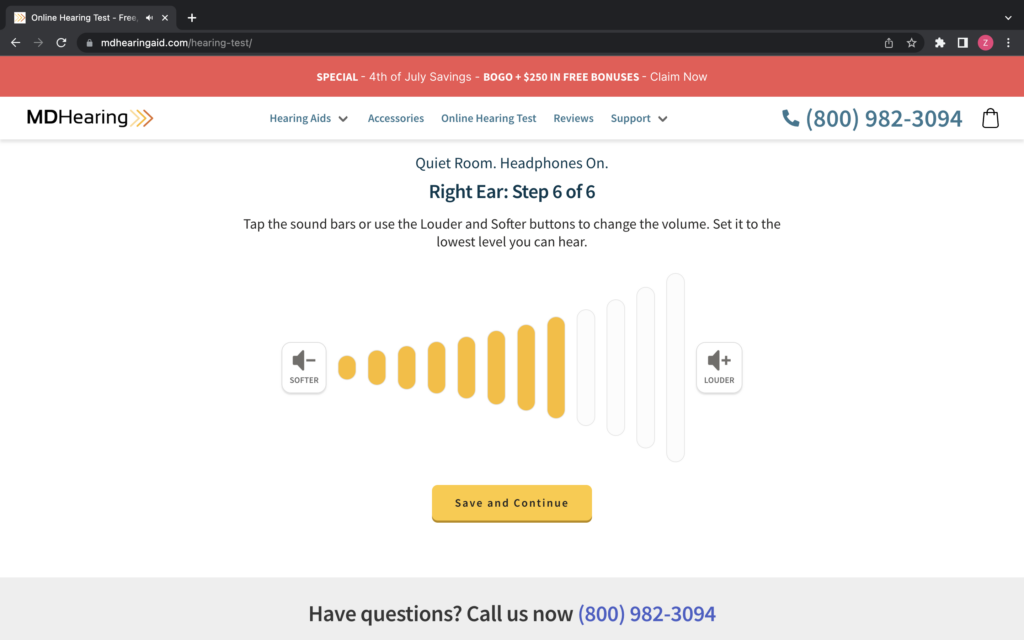
The test ends with your results, including a hearing loss meter for each ear. MDHearing offers the only test with an audiogram, which shows your hearing loss at certain frequencies. An audiogram can be confusing to read, so MDHearing explains how your hearing performs at low, middle, and high frequencies in greater detail. Check out the sample results below.
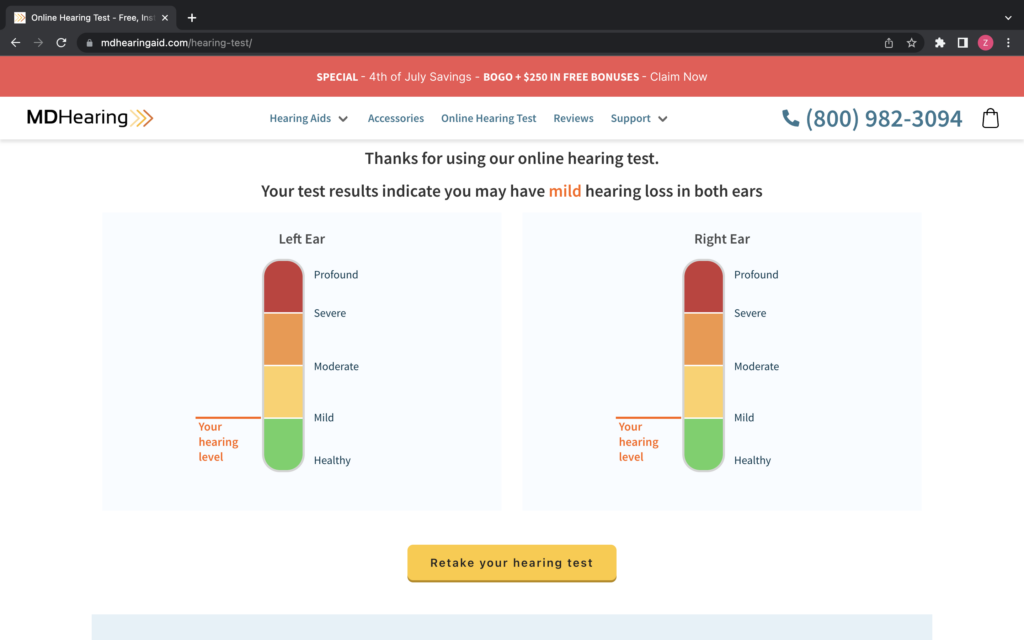
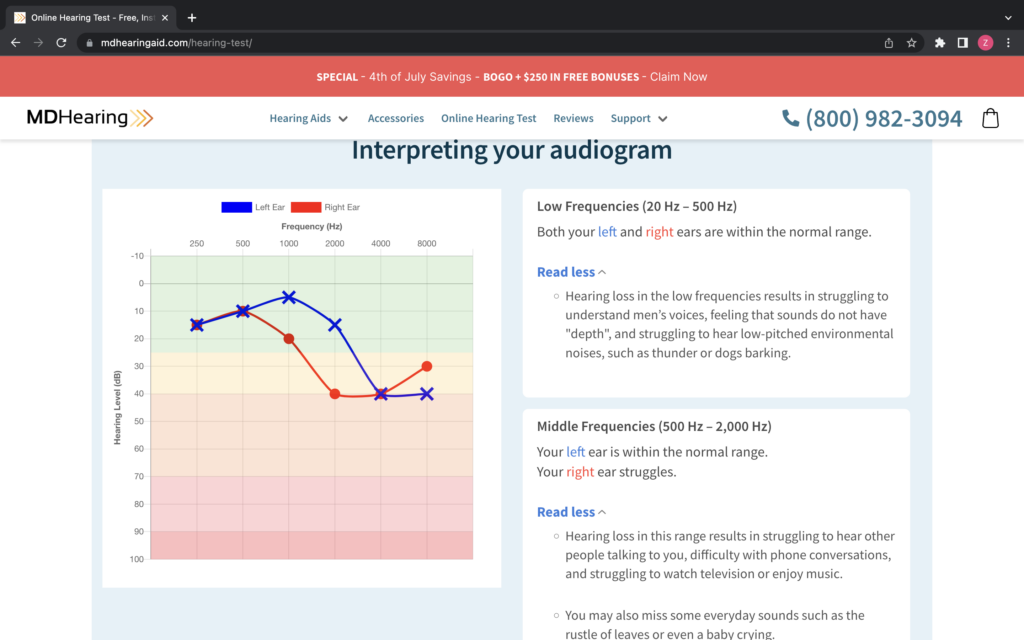
If your result states that you have severe or profound hearing loss in either ear, visit an audiologist to get a prescription hearing aid. You may need a hearing aid with more personalized technology to address your needs.
MDHearing App and Accessories
All hearing aids come with cleaning tools and chargers (if they have rechargeable batteries) to get you started, but you’ll have to buy extra accessories on the MDHearing website to upkeep or customize your devices. If you have the VOLT MAX, you get personalized programming through the MDHearing app.
Accessories
Some accessories are made specifically for certain hearing aid models. MDHearing’s website ensures that you’re shopping for accessories that are appropriate for your specific hearing aid by separating products based on the hearing aid you select. Here’s a breakdown of different accessories for each model and their prices.
Accessories for MDHearing NEO
- Bell-shaped domes ($9.99–$19.99): Choose between a pack of three to six small, medium, or large pairs.
- Wax guards ($15): Purchase a set of eight replacements.
- Cleaning tool set ($7.50): Get a set of three cleaning tools with a wire and brush similar to the BTE styles’ cleaning tools, but you won’t need the wire since ITE styles have no tubing.
- NEO Charger and carrying case ($99.95): Buy a charging port that doubles as a carrying case. (It is not a portable charger, so it needs to be plugged in to charge hearing aids.)
Accessories for MDHearing AIR, VOLT, and VOLT MAX
- Size 13 batteries: Choose between four ($3.95), eight ($6.95), or a box of 40 ($32.50) disposable batteries. Disposable batteries are only required for the AIR since it’s the only model with disposable batteries.
- Circular domes: Choose between a variety pack of the small, medium, and large pairs ($19.95) or three pairs of the same size ($7.50).
- ComfortTIPs: Replace a single tip ($7.50) or a pair ($15). Then select an open or closed fit and small or medium sizes.
- Cleaning tool set ($7.50): Purchase a set of three cleaning tools with a wire to clean tubing, a brush to remove external debris, and magnet to hold your disposable battery if you have the AIR.
- Thin tubing ($12.50–$20): Choose to replace a single tubing ($12.50) or a pair ($20). Then select your desired size. You can choose longer tubing if your hearing aid fits better with it.
- Tubing air blower ($5.95): Get this balloon-like gadget that attaches and directs air through your tubing, removing any debris and moisture.
- VOLT charger and carrying case ($99.99): Buy a charging port that doubles as a carrying case. It is not a portable charger, so it needs to be plugged in to charge hearing aids.
- VOLT portable charging case ($99.99): This portable charging case does not need to be plugged in to charge your hearing aids. It holds three charges before the case itself needs to be recharged.
Accessories for Any Model
- Dehumidifier jar ($15): Get an overnight storing jar with an inside lining that removes moisture to prolong their life.
- UV-clean and dry box ($99.99): Disinfect hearing aids while also removing moisture to prolong their life.
- Mack’s ProRinse Earwax Removal System ($15): Remove excess earwax from your canals before it affects your hearing aids and sound quality with this self-care kit to help.
MDHearing advises domes and tubes be replaced every three months for proper maintenance. They also advise daily cleaning of your hearing aids using the cleaning tool to ensure debris isn’t distorting your everyday hearing. We found the VOLT MAX’s dome was simple to remove and reattach, making the cleaning process easier than other BTE models we tested. You can use a tissue or soft cloth to help clean the outside of the device, but avoid cleaning agents like alcohol or water because the devices are not liquid resistant.
Other accessories include MDHearing’s QuietTV. It’s a rechargeable wireless headphone that lets you turn up the volume in your ears without disturbing others. You can control the volume of your headphone right on the device and use it for five to seven hours before needing to recharge. QuietTV works by connecting to an included device called the transmitter, which you plug in to the TV according to the user manual. Once it’s set up, the transmitter sends TV audio directly into your QuietTV using Bluetooth technology. The device is compatible with all TVs that allow connection to the Optical, Auxiliary, and RCA audio cords, which are also included. A single headphone is $149.99 and a pair of headphones would cost $199.99.
MDHearing App
If you have the VOLT MAX, you can take advantage of MDHearing’s app on your smartphone. It’s compatible with both iPhone iOS version 10 or higher and Android version 5 or higher. However, MDHearing’s customer support told us that the VOLT MAX has connectivity issues with Android phones and is more compatible with iPhone.

To pair with iPhone, follow these steps:
- Fully charge the hearing aids, but keep them in the case for now.
- Download the app and initiate setup by selecting the VOLT MAX and the hearing aids you want to prepare.
- Turn on the phone’s Bluetooth. The timing helps the app communicate with the phone’s Bluetooth for a seamless connection.
- Remove the hearing aid from the charging case to pair, one by one, as prompted.
To pair with Android, follow these steps:
- Fully charge the hearing aids, but keep them in the case for now.
- Download the app and initiate setup by selecting the VOLT MAX and the hearing aids you want to prepare.
- You’ll get a notification from the app asking for permission to access your location. Accept the request to connect to the hearing aid.
- Remove the hearing aid from the charging case to pair, one by one, as prompted.
Note: Do not pair the hearing aids directly with the phone outside of the app, because the app will not find them this way.
This process is different from other Bluetooth hearing aids, which pair to the phone first. It took us two attempts in five minutes to get it right, but once we had them connected, the app worked seamlessly with our hearing aids.
To finalize your setup, you will take a hearing assessment on the app with your hearing aids on. It takes about 10 minutes. The assessment establishes your ability to hear various tones to help create your personal profile and personalize the listening environments for you (automatic, quiet, conversation, or restaurant).
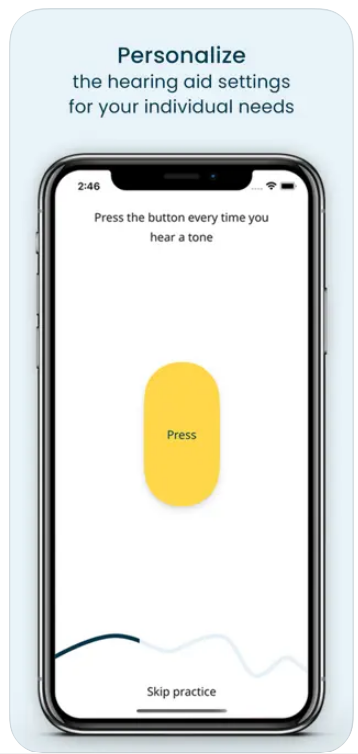
Other app features include volume controls and customer support. You can control volume for individual hearing aids or the pair. If you need help adjusting your hearing aids, you can access the Support tab to call or email customer support. For specific programming adjustments, you can submit a ticket to receive fine-tune assistance. You start by answering a questionnaire about what you’re experiencing. A MDHearing hearing professional may ask you to retake the hearing assessment through the app to compare to the one from your personal profile. Based on the information you provide, they will make necessary adjustments in one or two days. They text you when the adjustment is ready to download from the app into your hearing aids—all without leaving your home.
Price and Payment Options
MDHearing’s AIR, NEO, VOLT, and VOLT MAX hearing aid models range from $399.99–$799.99 per single device, and $299.99–$699.98 per pair. Because MDHearing runs frequent promotions on their products, purchasing a pair is typically cheaper than purchasing a single device. We’ve yet to see the products listed at their full retail prices online.
Although MDHearing’s OTC hearing aids are at lower price points than many others we’ve tested, they can still be out of budget for many. Thankfully, MDHearing does offer three-, six-, or 12-month financing options through Affirm with 0% APR. You can see if you qualify at online checkout. You may be subject to a down payment depending on your approval.

Historically, cost is one of the biggest barriers for people to access hearing aids. Many charities collect and distribute recycled hearing aids for those who need them but have trouble affording them. If you’re having trouble affording a monthly payment financing plan, reach out to national organizations like the Hearing Loss Association of America to see if they can connect you with support. Their website has a section dedicated to financial assistance, including a downloadable Financial Assistance Guide that directs you to specific resources that can help you access hearing care.
Does MDHearing Accept Insurance?
Unfortunately, most insurance plans do not cover the cost of hearing aids. Medicare Part A and B don’t cover hearing aids or exams, but some Medicare Advantage Plans (Part C) might.
To see if your insurance will cover an exam or a hearing aid, call your provider. If there’s a chance that they will cover any cost, you can go to the provider’s website and look for a reimbursement form to submit to your insurance. You can also request necessary documentation from MDHearing, like a detailed medical invoice or a Superbill, to submit the information with the form.
Some insurances offer Flexible Spending Accounts (FSA) or Health Saving Accounts (HSA) to set aside finances for medical expenses. If you’ve been contributing to an FSA or HSA, you may be able to use those funds to pay for your hearing aids. Find out if hearing aids are an eligible expense by reaching out to your insurance company.
How to Purchase MDHearing Devices
MDHearing hearing aids are available for purchase online only. The purchase process is straightforward on their website. Once you’ve added your hearing aid (and accessories, if necessary) to your cart, you can checkout by selecting the shopping bag at the top right of the page.
The checkout page will prompt you to fill out your personal information needed to process your order. It will also give you an opportunity to add accessories to your order if needed, but it’s optional. The next step is to select your shipping option and payment method. Standard shipping is free, but the option to pay for faster shipping like Next Day Air is available. You can qualify for financing options through Affirm on the payment page.

Trial Period and Warranty
MDHearing offers a 45-day trial period with a 100% money-back guarantee if you’re not satisfied. To receive a refund, you must return your hearing aids with a shipping date within the 45 days. An important note: A full refund is only given to those who include the Return Merchandise Authorization (RMA) code on the packaging, otherwise you will be charged 20% of your refund to process your return. To get the RMA code, you have to contact customer service. MDHearing’s Protection Manual has a great infographic (see below) on the do’s and don’ts of hearing aid returns for your reference.
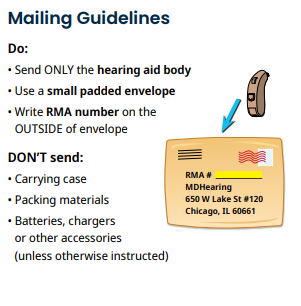
They also offer a one-year warranty on the AIR, NEO, and VOLT hearing aids. If you purchase the VOLT MAX, it comes with a two-year warranty. All warranties cover faulty parts or defects from the day you receive your order. If the repair falls under the warranty, you get a free repair or replacement. It doesn’t cover any repairs or replacements due to inflicted damages, like misuse, poor maintenance, or loss. It also doesn’t cover most accessories, with the exception of the QuietTV wireless headphones which do come with the same one-year warranty.
If you want full coverage from all damages, you can purchase the MDShield Protection Plan for $9.99 per month at checkout. The plan is the same price for the AIR, NEO, VOLT, and VOLT MAX. If you opt out of the plan at checkout but want to purchase it later, you must purchase the plan separately. You’ll find it under MDHearing accessories. It covers the entire cost of repair or replacement for all defects, malfunctions, and accidental damages; however, it does not cover loss, theft, or unauthorized repairs. You can cancel the plan at any time without a fee. QuietTV is the only accessory covered by MDShield at only $3.99 per month under the same terms.
Customer Service
MDHearing has United States-based customer service available via phone, email, an online form, and online chat. During our brand research, we contacted each mode of customer support.
Phone: You can call MDHearing at 800-982-3094 or 800-918-3914 to reach customer service. They are available Monday through Friday from 7 a.m. to 6 p.m. CST time. We called customer service on two occasions, both took about one hour to connect to a representative. Once connected, they were very knowledgeable about the products offered online and answered every question thoroughly.
Email: You can address an email to [email protected], which they state is available 24/7. We wrote two emails to this address, both of which were answered in one to two business days after an initial automated request receipt. We sent one of the emails on a Friday, and we didn’t receive a response until Monday morning.
Online form: MDHearing lets you submit a message through their online contact form, and you should get a response within two business days. You will need to provide your first name, email, and phone number. We submitted a message through this form and never received a response back.
Chat: The chat feature intermittently appears as a help bar at the bottom right of the website. We were never able to chat with a support representative because they were always offline. But, when you type your question into the query bar, it does answer some commonly asked questions regarding products and maintenance by providing links to resources or video tutorials. You can fill out an online contact form here too—just press the Send Message button.

If you have the VOLT MAX, you can access customer service through your MDHearing app under Support. When we used this feature, it took three minutes before we received a message back. It only left a call-back number, and no support agent was available to help.
What to Consider Before Purchasing MDHearing Hearing Aids
OTC hearing aids aren’t appropriate for everyone. The new FDA ruling stated that OTC hearing aids like MDHearing’s devices are only appropriate for those over the age of 18 with mild to moderate hearing loss. Children, teens and those with severe to profound hearing loss require a full exam by an audiologist to diagnose the condition and prescribe appropriate hearing devices.
Also bear in mind that an online hearing test is not designed to replace a clinical hearing test performed by a hearing professional or audiologist. It’s a good idea to get your hearing thoroughly tested by a professional if you suspect hearing loss. Audiologists can provide proper diagnosis while ruling out excess accumulation of earwax, known as earwax impaction, or any medical conditions that can cause hearing loss. They will also personalize treatment guidance to your unique needs.
“Hearing loss is complex. Hearing aids are retraining your brain to accept sound,” said Trisha Muth, Au.D., an audiologist at Bay Area Audiology. “Purchasing hearing aids is more complex than just making the initial purchase albeit online or in-office,” she said. “The evaluation that goes into selecting the device, the programming of the device, and the follow-up care associated with the hearing aids are equally, if not more important, than the purchase of the devices alone.”
Note that only MDHearing’s AIR model offers telecoil. When asked why this feature isn’t included in all MDHearing models, customer support informed us that telecoil technology spikes the price of the hearing aid, and their main priority was to make their hearing aids affordable for users. If you often use telecoil at your place of worship or local cinema, MDHearing devices may not be for you.
Comparing MDHearing to Other Brands
| Brand | Price | Prescription or OTC | Model | Hearing Loss |
|---|---|---|---|---|
| MDHearing | $299.99–$699.99/pair | OTC | In-the-canal (ITC), behind-the-ear (BTE) | Mild to moderately severe |
| Lexie | $799–$999/pair | OTC | Behind-the-ear (BTE), receiver-in-canal (RIC) | Mild to moderate |
| Jabra Enhance | $1,195–$1,995/pair | OTC | Behind-the-ear (BTE), receiver-in-canal (RIC) | Mild to moderate |
| Widex | Varies by retailer, generally $2798–$4,598/pair | Prescription | Behind-the-ear (BTE), receiver-in-canal (RIC), in-the-canal (ITC) | Mild to profound |
| Brand | ||||||||||||||||||||||||||||||||||||||||
| MDHearing | Price | $299.99–$699.99/pair | Prescription or OTC | OTC | Model | In-the-canal (ITC), behind-the-ear (BTE) | Hearing Loss | Mild to moderately severe |
|---|
| Lexie | Price | $799–$999/pair | Prescription or OTC | OTC | Model | Behind-the-ear (BTE), receiver-in-canal (RIC) | Hearing Loss | Mild to moderate |
|---|
| Jabra Enhance | Price | $1,195–$1,995/pair | Prescription or OTC | OTC | Model | Behind-the-ear (BTE), receiver-in-canal (RIC) | Hearing Loss | Mild to moderate |
|---|
| Widex | Price | Varies by retailer, generally $2798–$4,598/pair | Prescription or OTC | Prescription | Model | Behind-the-ear (BTE), receiver-in-canal (RIC), in-the-canal (ITC) | Hearing Loss | Mild to profound |
|---|
MDHearing Reviews and Reputation
As of this writing, MDHearing (listed as MDHearingAid, its former title) is not accredited by Better Business Bureau (BBB), has 3.88/5 stars out of more than 80 customer reviews, and has decreased from a B rating to an F rating. BBB issued statements on MDHearing’s profile identifying violations against their advertising rules by using inaccurate information, like longer-than-advertised sales and an A+ BBB rating, to market their products. We reached out for a statement and were directed to read an article on their website defending their position against BBB.
Despite the violations, customers have left mostly positive reviews for the company and its products. Customers praised sound quality and friendly customer support staff, but some negative reviews noted they found it difficult to reach customer support and experienced long hold times.
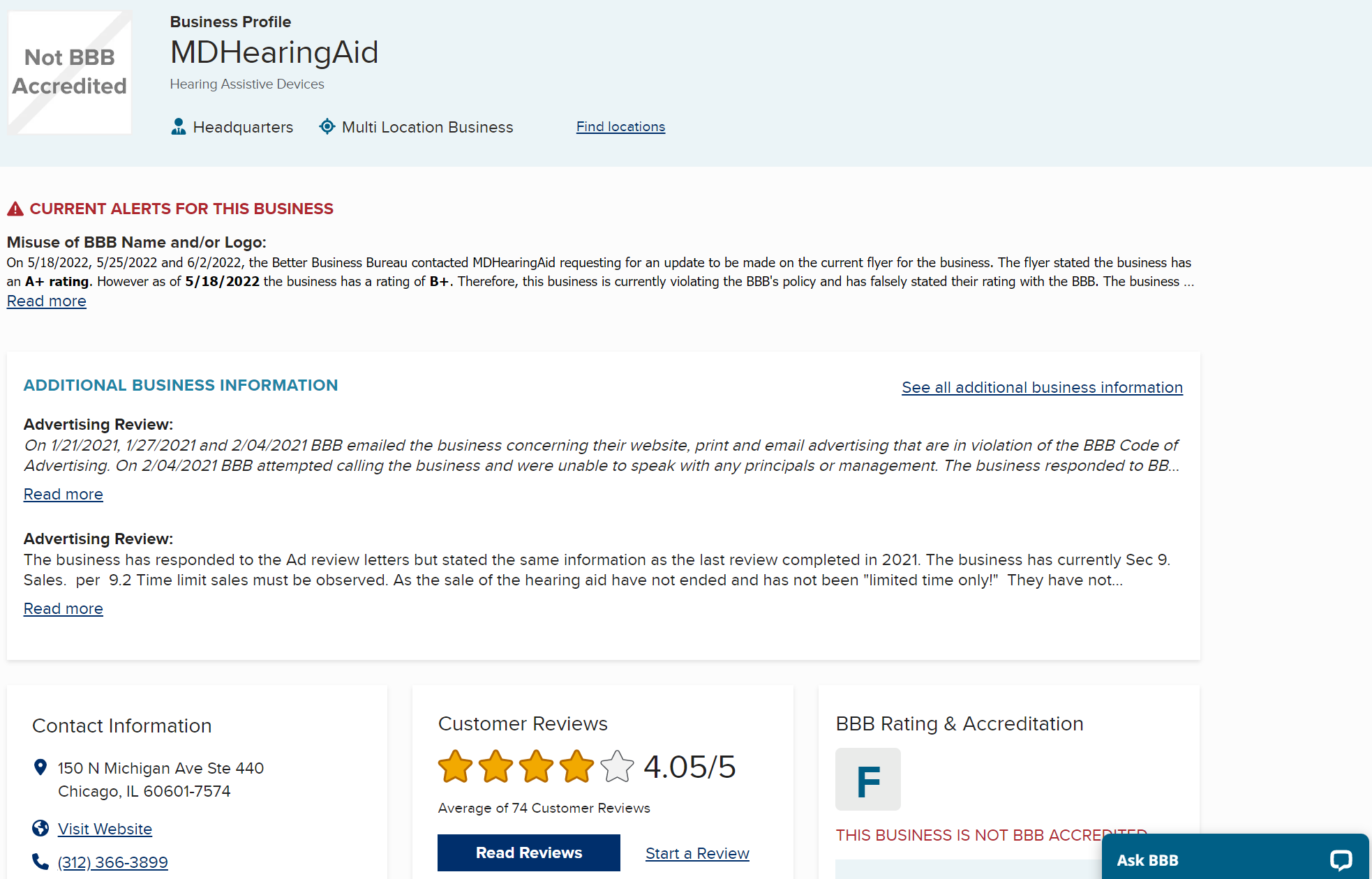
On Trustpilot, MDHearing received 2.8/5 stars but with minimal customer reviews, so it doesn’t give a good sense of the overall customer experience.

We also found reviews for individual MDHearing products on Google Shopping, which gave us more of an idea of how users felt about each one.
- MDHearing AIR received 4.2/5 stars with more than 3,000 customer reviews. This is the highest rated hearing aid, with many reviews praising the fit and sound quality. Some negative reviews disagreed, reporting poor sound quality and discomfort.
- MDHearing NEO received 2.8/5 stars with more than 165 customer reviews, with negative reviews reporting uncomfortable fit in the canal, while positive reviews praised sound quality.
- MDHearing VOLT received 3.8/5 stars with more than 6,000 customer reviews. Positive comments praised the comfort, good sound quality, and ease of use. However, some claimed that the hearing aids were bulky.
- MDHearing VOLT MAX received 3.5/5 stars with more than 500 customer reviews. Many liked the product and the app, but negative reviews reported an uncomfortable fit with frequent feedback noise.
Bottom Line
MDHearing hearing aids may be a good choice if you seek simple, straightforward, budget-friendly technology that addresses mild to moderately severe hearing loss.
The AIR is great for those who prefer the longer life of disposable zinc-air batteries. The NEO is the ITC option for those who prioritize discreet fit. The VOLT offers more advanced sound processing for the same price per pair as the NEO and AIR. And finally, the VOLT MAX offers the highest level of sound processing and Bluetooth connectivity for easy setting selections and access to customer support.
If you suspect severe to profound hearing loss, MDHearing hearing aids are not for you. Instead, visit your audiologist for a thorough hearing exam and receive appropriate care for your hearing loss. A prescription device may be more appropriate.
Frequently Asked Questions
-
Yes, MDHearing is a legitimate, FDA-registered company that sells OTC hearing aids. As of September 2022, MDHearing’s VOLT MAX hearing aid received 510(k) approval from the FDA after clinically demonstrating its safety and efficacy.
-
MDHearing’s VOLT model is a medical-grade OTC hearing aid that addresses mild to moderately severe hearing loss. Amplifiers are not medical grade or regulated by the FDA and should not be used to address hearing loss.
-
MDHearing hearing aids are good for those with mild to moderately severe hearing loss who prefer a product with basic, easy-to-use functions like volume control and feedback cancellation. Customers praise their sound quality. However, many reviewers disliked the fit.
-
MDHearing is an FDA-registered company, which means they have registered their manufacturer with the FDA. MDHearing’s smart hearing aids, the VOLT MAX, has 510(k) approval deeming them safe and effective by the FDA.
-
MDHearing’s AIR model uses size 13 zinc-air disposable batteries that last 21–26 days. MDHearing’s NEO, VOLT, and VOLT MAX use rechargeable batteries that last 17, 20, and 15 hours, respectively.
WRITTEN BY
Nicole Hernandez is passionate about empowering people to live their lives to the fullest. She is a licensed DPT (doctor of physical therapy) in Nevada and received her degree from Campbell University in North Carolina. Nicole has used her degree to treat patients, produce research, and publish online pieces regarding health and rehabilitation. Now, her primary focus is to produce evidence-based content for AgingInPlace.org to ensure people receive the most factual information available as they make important decisions regarding their wellness journey.
View AuthorMEDICALLY REVIEWED BY
Brian Murray earned a bachelor's of science degree in Speech Language Pathology and Audiology in 2010 from Ithaca College. He is licensed to dispense hearing aids in New York, North Carolina, and Virginia, where he has worked in both private practice and retail clinics. He is currently a workshop consultant with Alpaca Audiology.
View Reviewer- Comparison of Hearing Aid Fitting Outcomes Between Self-fit and Professional Fit for MDHearing Smart Hearing Aids | Clinicaltrials.gov
- MDHearing Receives FDA 510(k) Approval for Its Self-Fitting Smart Hearing Aids | MDHearing
- Quick Statistics About Hearing | National Institute on Deafness and Other Disorders
- What Keeps Older Adults With Hearing Impairment From Adopting Hearing Aids? | Trends in Hearing
- Your Guide to Financial Assistance for Hearing Aids | Hearing Industries Association
- 510(k) Premarket Notification | U.S. Department of Health and Human Services
Do you want to cite this page? Use our ready-made cite template.

